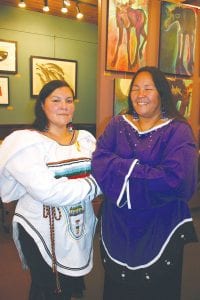Concerns about everyday worries just washed away when two rays of the sunshine, Nina Segalowitz, and Taqralik Partridge took the floor at Siverton’s Art Gallery on Saturday, October 15.
The two Inuit throat singers, who met in college and learned the ancient vocal technique in which a single voice produces more than one tone at the same time, performed in front of several hundred enthusiastic fans— friends—over the three free concerts they gave that day.
Describing the myriad, sometimes guttural, sometimes melodic sounds throat singers make is like trying to explain the aching soul-searching song pods whales make when they communicate: it feels like a throwback to an ancient time, beautiful, haunting, riveting, gripping, inexplicable.
And, quipped Partridge, “Sometimes we sound like crazy aliens from another world.”
Yes, funny too.
Taqralik said throat singing is a traditional Inuit game that dates back hundreds of years. Women face each other, often holding hands, and play it. One leads to a sound mimicking the wind, the river, the ocean or an animal, while the other follows. The object of the game is to make the other person stop because of exhaustion, or laughter, or one of them loses the rhythm and the song ends.
Taqralik is originally from Kuujjuaq, Nunavik. She is a spoken word performer, voice actor, poet and throat singer.
When Nina Segalowitz was an infant she became sick and her father took her to the hospital. Once there he was asked to sign some papers, and he signed them. The documents stated that the Canadian government could take Nina from her mother’s arms and another family would raise her far from her Inuit home in the Northwest Territories.
“It was part of the Canadian government’s relocation program for native children in the 1960s and 1970s,” said Nina.
A Polish Jewish family who lived in Montreal adopted her. Her adoptive mother is from the Philippines, and Nina grew up learning Hebrew in the synagogue that her adoptive father attended and Tagalog in the Catholic Church her Philippino mother attended.
“My adoptive family loved me, but I couldn’t see anyone that looked like me in that culture. Something was missing. In 1995 I began looking for my biological family. After a couple of years, I found them, taking a plane to Fort Smith in the Northwest Territories. When I met my father he took me in his arms and we cried. A hole in my heart was closed.”
Nina’s mother didn’t understand what the signed papers had meant. “She never knew why they took me from her,” said Nina.
“I was told my mother would go back to the hospital every day and ask for me. She would scream at the nurses and doctors, calling after me. I never got to meet her. By the time I had found my family my mother had passed away. They say I look just like her so when I look in the mirror I can see my mom.”
She smiled through tears when she said that.
And then the ladies sang again. Taking the listeners on a journey, describing the meanings behind the songs as they went, sharing their culture and heritage along the way, mixing laughter and joy into the recipe of their lives, and they promised to come back next year. Maybe with a CD to sell. Be sure not to miss it.



Loading Comments